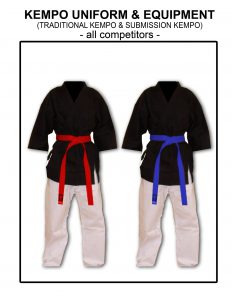WEAPON KATA
(Weapon Forms)
Attention!
WEAPON KATA rules must be organized obligatory in all National Cups and Championships, Continental Cups and Championships, World Cups and Championships.
By IKF decision, these rules can be organized for individuals or/and teams championships as well.
All IKF members will update their constitutions and will apply these rules accordingly in their countries.
In WEAPONS KATA division, a competitor or team shows their skills about a particular weapon Kata of their choice. This weapon Kata can be a traditional or a modern weapon form (NO FIRE GUNS WEAPONS ARE ALLOWED !!!).
- Weapons Kata has been created for real defending. By knowing this, the weapons used in this division must look like real weapons but without any sharp parts.
- also the traditional weapons like Katana (sword), Kama (sickle), Tanto (knife), Tonfa, and more has to be made from Iron / Metal / Wood and not from plastic or silicon (excepting athletes under 18 years old)
- inside the WEAPON KATA division there are 2 subdivisions: WEAPON KATA INDIVIDUAL and WEAPON KATA SYNCHRONIC.
- in Weapon Kata Individual will compete with just single competitors and in Weapon Kata Synchronic will compete with just teams composed of 3 members.
Safety
- each weapon must be not sharp, in good shape and safe for the competitor, referees, and audience.
- before starting a weapon competition, the weapon will be checked by the referees.
- each weapon which is not safe, will be taken out of competition; the competitor or team can stay in the competition but has to use another weapon, safe provided and checked by a referee.
- only the competitor is responsible for his weapon, nobody else.
- weapons have to be covered with a safety cover when outside of the competition area.
Presentation
- when the specified category will be called, all competitors from that category will take place on the chairs in the back of the competition area; they will not leave their chairs until the announcement of the head referee.when their turn comes, the competitors have to enter the tatami at the head referee’s announcement, and start their presentation as follows: competitors walk in front of the head referee, salutes, and speaks out loud as follows:
For individual kata: NAME – COUNTRY – WEAPON KATA (Example: Robert Zingg – USA – Tonfa Ichi)
For synchronic kata: COUNTRY – TEAM Nr. – WEAPON KATA (Example: USA – Team 1 – Tonfa Ichi)
- all competitors will start their performance just after the signal of the head referee.
- at the end of their performance, competitors will salute the head referee again, waiting for the decision decently.
The time limit
- the maximum time is 3 minutes.
- the time will start from the salute for starting to perform until the salute at the end of the performance.
- if the time limit will be overlap, the scorekeeper will give the sign “TIME OVERLAP” to the head referee.
- the head referee will inform after finish the performance, the competitor or team, and the audients that the time limit is overlapped.
- if the time it was overlap, the head referee will disqualify the competitor or team.
How to win
- the decision will be taken by the majority of referees.
- the WEAPON KATA competition uses an eliminatory system; there will be always one competitor competing against another competitor, or one team competing against another team.
- the winner will go forward in the next round, and the loser is eliminated.
- the last 4 competitors or teams will compete for places 1st to 4th.
Refereeing and Judgments
- the refereeing system within the International Kempo Federation is by having 3-5 referees.
- the referee team is separated into one head referee and 2 or 4 side referees.
- in the semi-finals, there are 3 referees from different countries.
- in the finals, there are 3 or 5 referees depending on the organizer staff of the IKF.
- the decision will be taken directly by the referees as follows: the side referees and the head referee will watch in the same direction and they will show the winner of them directly by their blue or red stick, at once, at the sign of the head referee.
- the decision will be taken by the majority of referees.
- a referee who was not present in the referee course on the day before the competition will be not allowed to act as a referee in that event.
- the following principles are very important if we have to judge a performance in KATA.
- every referee must have the knowledge and must be able to give the right interpretation of upper rules.
The 7 PRINCIPLES of WEAPON KATA
- WEAPON KATA has to be alive and has to carry out with feeling. It must be clear what the techniques are for, by getting them a combat value. A WEAPON KATA must be not like “a dance”, nice for looking, having not a combat value of techniques.
- There has to be “spirit”. Energy, force, and mind must come together in one point in a short moment. Here we can talk about “Focus”.
- The power of strong and weak, hard and soft, flex, and relax. This we have to see in a WEAPON KATA.
- The timing of fast and slow. There has to be a variation in speed. There is a difference between action and no action in a WEAPON KATA. In this manner, there will be a rhythm in the also by getting a character and a feeling of a battle.
- Rhythm of breathing, the right way of breathing in and out. Gather power and energy in the area of our energy-center in the lower abdomen.
- Balance is in every exercise very important. For right and effective techniques it’s important to have a good balance of the body. Some techniques in a WEAPON KATA are just for the development balance of the body.
- Synchronization is very important in WEAPON KATA SYNCHRONIC.
Referees /judges must have always in their mind the following questions in order to judge correctly :
1. How was the PRESENTATION?
2. How was the SYNCHRONIZATION?
3. How was his attitude? Did he looks like a fighter or was his attitude weak during the whole presentation?
4. How was his BREATHING? It was good? It was not good?
5. How was his BALANCE? Did he lose his balance during the performance? He was strong on his legs?
6. How it was applied HARD/SOFT, the main principle of Kempo? It was just Soft movements? It was just HARD movements?
7. How was his KIME? Did he show he is a fighter by his attitude? Did he look like having a real fight, a real battle during his WEAPON KATA? Did he induct you the feeling that something strong and focused was inside of his performance, or did his movements look just like a dance, just like a beautiful succession of movements and that’s it?
Disqualification
- if one competitor/team is not coming to compete after 1 minute after the last call, follows disqualification.
- when a competitor or team stops the performance before the end, disqualification will follow.
- when a competitor or a member of a team moves out of the competition area, the competitor or the team will be disqualified.
- when performance is more than the time limit.
WEAPON KATA SYNCHRON
– Page Under Construction –
We apologise for any inconvenience caused during these construction works safety sign notice.
WEAPON KATA – official list.
*Note: This list will be upgraded with all Weapon Kata received from the new IKF members. Despite this list, all competitors are allowed to perform their specific Weapon Kata at their discretion.
| WEAPON KATA (Weapin Forms) | |||
| Name | Country | ||
| Bo In-Yo Dohsa-In | Romania, Holland | ||
| Bo In-Yo Dohsa In-Yo | Romania, Holland | ||
| Bo In-Yo Dohsa Yo | Romania, Holland | ||
| Bo no Forms Shodan | USA | ||
| Brania | Bulgaria | ||
| Chatan Yara no Sai | USA | ||
| Cho un no Kon | Romania, Holland | ||
| Ed Parker Hanbo Set | USA | ||
| Ed Parker Kai bo Set #7 | USA | ||
| Ed Parker Formsna Set | USA | ||
| Ed Parker Kenpo Dagger Set | USA | ||
| Ed Parker Kenpo Dagger Set | USA | ||
| Ed Parker Kenpo Saber Set # 2 | USA | ||
| Ed Parker Kenpo Spear Set | USA | ||
| Ed Parker Staff Set #1 | USA | ||
| Ed Parker Staff Set #2 | USA | ||
| Ed Parker Tanto Set #8 | USA | ||
| Haso no Kun | USA | ||
| Jo no Forms Nidan | USA | ||
| Jo no Forms Shodan | USA | ||
| Kaneshima no Kama | USA | ||
| Kaneshima no Sai | USA | ||
| Kaneshima no Tonfa | USA | ||
| Kohbu ni chou Gama | Holland | ||
| Kohbu no Shuchu | Holland | ||
| Koh-bu Nunchaku | Romania, Holland | ||
| Kube–In | Bulgaria | ||
| Matayoshi no Kuwa no de | Holland | ||
| Miyazato no Nunchaku | USA | ||
| Ni cho zai | Romania, Holland | ||
| Nunchaku no Kata | Holland | ||
| Nunchaku no Forms Shodan | USA | ||
| Pastir | Bulgaria | ||
| Ratnik–Az | Bulgaria | ||
| Ratnik–Buki | Bulgaria | ||
| Saku gawa no Kon | Holland | ||
| San chou zai | Holland | ||
| Seibu Nunchaku | Romania, Holland | ||
| Shi i shi no Kon | Holland | ||
| Shu shi no Kon | Holland, USA | ||
| Tokumine no Kun | USA | ||
| Tonfa Ichi | Romania, Holland | ||
| Tsuken akachu no Iyeku de | Holland | ||
| Tsuken no Kon | Holland | ||
| Ufugushuku no Kon | USA |
WEAPON KATA
(tournaments organization)
By the decision of the organizer, WEAPON KATA categories can be divided in two separate groups: Hard and Soft.

